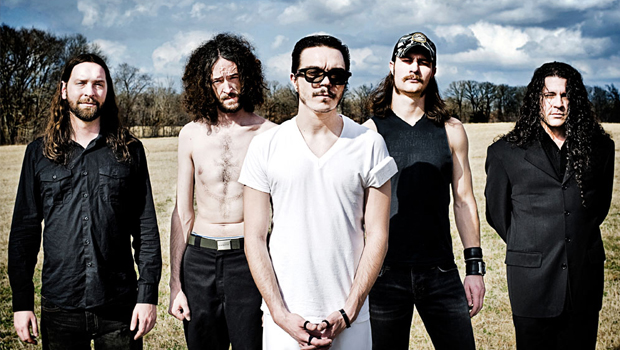
"It makes you wonder / if the beaten path is the promised land!" sings Fair To Midland's Darroh Sudderth on "Musical Chairs," the lead single from the band's latest album, Arrows and Anchors.
Off the beaten path is a great way to describe the sound of the Sulphur Springs, Texas-based band. Mixing folk sounds with progressive rock elements with a good dose of Southern rock swagger, Fair To Midland have emerged from their recent bout of record label woes (Read more and see the video for "Musical Chairs" here) a more focused, more driven band, and it shows on Arrows and Anchors.
We recently got the chance to talk to Fair To Midland guitarist Cliff Campbell about the new album, which can be streamed in its entirety at this location.
GUITAR WORLD: Arrows and Anchors is definitely a new step for you guys. Was there anything in the songwriting process that took the album in a different direction?
It started a lot like the last album, but I think we started taking more influence from more straight-up rock 'n' roll. The progressiveness is still there, of course, but there are a lot more rock riffs there that didn't really exist before so much on Fables. We were looking for a big, epic feel on that album, and we still do that same thing, but those moments of rock just really needed to be captured, and I think we really did that on quite a few of the songs.
I think it's got more of a live appeal, and we were really striving for that in a lot of the material. I think a lot of our Southern rock influence came across well on this album.
It seems like the band really found their voice on this album. Would you agree with that?
Get The Pick Newsletter
All the latest guitar news, interviews, lessons, reviews, deals and more, direct to your inbox!
Oh yeah, completely, man. I think we also came together more as a collaborative than we did on the last album. As a band that's progressed over the years, changing bass players five years ago, for instance, the influence only slow-peeks in over the years, and you start respecting each other more. Jon definitely brought in this more straight-ahead, Southern rock influence I really liked as well, but I never let it seep into the music as much as I did on this album.
Do you have any influences that might surprise your fans?
I don't know. I like the new Lady Gaga album. That might throw 'em for a loop!
No one ever brings up Yes, and they're a really big influence on us. You can totally hear some of that aesthetic behind the music. They're kind of a folksy, progressive band ...
Speaking of the folk elements, you guys have made pretty extensive use of banjo and mandolin in the past. That's a pretty unique thing for a heavy, progressive band to do. Where does that come from?
That's something that [Darroh] listens to a lot. I listened to country until I was probably 13 years old; I didn't really know what rock was until my step-brother moved in the house and showed me Def Leppard. [laughs]
So you guys worked with Joe Baressi (Tool, Queens of the Stone Age, Clutch, Isis) on this album. What did be bring to the table?
He brought the tone. He just totally expanded our tone and made us sound like the rock band we wanted to be.
I'm not the expert on any of that stuff, but I was able to say, "This needs a little more sizzle on it," or "This sounds really beefy, but I don't feel the round tone," and it was just instant. He brought like three trunks completely full of effects pedals and it didn't matter what the tone was, he just instantly knew what it was and had it there.
Talk about some of the effects you used on this album.
Well, it was funny; on half of them he would have the name taped over and something else written on it because he didn't anyone to know what it was. [laughs]
It was freakin' hilarious; he had this one amp -- I think it was a Peavey -- that had a piece of tape on it that just said "Mississippi Marshall," and he would literally not say what it was. We had a guy video-taping the entire process, and [Joe] would say, "Don't mess with any of that; that's my gear."
But it was awesome. He had so much pride in the tones that he got, it was amazing.
What sort of amps did you use for the album
The main amps were my Naylor Super 60 and a Rivera. I used a Peavey 6505 head, which was more of a tone that I would overlay.
What were your main guitars for Arrows and Anchors?
I used my [PRS] Custom 22 a lot, and I used a [PRS] Mira that they sent me a little bit before we started recording. It was weird because we actually used the Mira probably 75 percent of the time and I didn't expect to do that. The 22 kind of holds the tuning better and intonates better and always sounded better in a live setting, but when we went into the studio, the Mira prevailed. The Mira has kind of an SG tone, but it just seemed to have a lot more body to it than the 22, and Joe agreed so we ended up sticking with that.The new album from Fair To Midland, Arrows and Anchors, is out tomorrow, July 12, via E1 Music.
Josh Hart is a former web producer and staff writer for Guitar World and Guitar Aficionado magazines (2010–2012). He has since pursued writing fiction under various pseudonyms while exploring the technical underpinnings of journalism, now serving as a senior software engineer for The Seattle Times.
“I always felt like that record could have been better if we had worked on it some more”: Looking for a blockbuster comeback album, Aerosmith turned to Van Halen producer Ted Templeman. For Joe Perry, it served as a learning experience
Guitar World Discussion: Who is the most underrated guitar player of all time?











